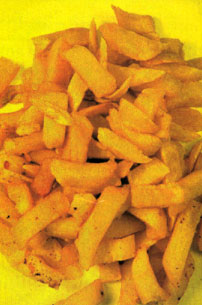| 2003 |

|
YEAR BOOK |
Food Safety Authority of Ireland
|
Acrylamide - a new food safety issue
|

Acrylamide is mainly used in industry to produce polymers known as polyacrylamides, which in turn are used as flocculants or coagulants to condition sludge, to clarify raw water and to treat effluent streams from sewage plants. It is known to be present in tobacco smoke, and residual traces are found in drinking water, due to the use of polyacrylamides as clarifying agents for water.
The chemical had never before been reported in food, but it has undoubtedly been present in the human diet since man first began cooking, and its detection in food opened up a further possible link between diet and cancer. The Swedish findings have since been confirmed by many other food safety regulatory authorities and by the food industry. Acrylamide has been found in a wide variety of fried, baked or roasted foods - e.g. chips and potato crisps, cereals and crispbreads, but also in products such as roasted coffee beans. Approximately 38 percent of the foods we eat contain acrylamide, linked to their carbohydrate (starch) content.
It has now been shown 1,2 that the process that produces the browning and flavour-producing changes during high-temperature cooking, the so-called Maillard reaction, is also responsible for the formation of acrylamide. This involves reaction of amino acids with reducing sugars, found in starchy foods. The presence of the amino acid asparagine and the reducing sugars glucose and fructose are critical for acrylamide formation, and potatoes (and to a lesser extent cereals) contain high levels of asparagine. Fried or baked potato-based foods are thus a major source of acrylamide in the human diet.
Prolonged storage of potatoes, particularly at low temperatures, leads to an increase in reducing sugar content and hence an increase in acrylamide levels when the potatoes are cooked (Grob et al., in press). Cooking temperatures and times influence the formation of acrylamide, with increasing levels being detected at 120�C upwards. Grob and co-workers have also shown that the levels of acrylamide formed are cultivar-dependent, and that blanching of the uncooked potato before cooking reduces levels. These findings have been confirmed by ongoing research in industry.
A key issue for public health and food safety authorities is whether acrylamide is truly a risk to human health. The assessment of the risk remains hampered by lack of knowledge about the underlying toxicology, epidemiology and how people are exposed to acrylamide in food. Preliminary evaluations have not found any correlation between intake of foods known to contain high levels of acrylamide and cancer, nor is there any definite evidence from epidemiological studies that it causes cancer in people exposed to high levels of acrylamide at work. The risks presented by acrylamide in food may therefore be overestimated. Nevertheless, acrylamide is considered to be a genotoxic (DNA-damaging) carcinogen, and a precautionary approach must be taken, including the assumption that there is no safe level for acrylamide in food.
The recent findings on how acrylamide is formed in food provide a basis for giving consumers appropriate dietary advice, and also for measures to be taken to reduce the levels of acrylamide in food. However, it is difficult at this stage for food safety authorities to know what advice to give. The conditions which lead to acrylamide formation are also the ones which lead to the characteristic flavours and appealing colours associated with the frying, roasting and baking processes. Acrylamide levels can be reduced by cooking at lower temperatures or for shorter periods, but this results in less appealing or palatable food. Consumers will have to be educated to accept these changes in food appearance and taste. More importantly, such changes in cooking practice may ultimately be more hazardous for the consumer because of the risk of food poisoning, since all food, particularly meat, must be cooked thoroughly to destroy food-borne pathogens.
References
1.�Acrylamide is formed in the Maillard reaction. Mottram, D.S., Wedzicha, B.L., Dodson, A.T. (2002). Nature, 419, 448-449.
2.�Acrylamide from Maillard reaction products. Stadler, R.H., Blank, I., Varga, N., Robert, F., Hau, J., Guy, P.A. , Robert, M-C, Riediker, S. (2002). Nature, 419, 449-450.
Contact: Dr Iona Pratt, Food Safety Authority of Ireland,
Abbey Court, Lower Abbey Street, Dublin 1;
Tel: 01-8171300; Fax 01-8171301; E-mail: [email protected] ; Web: www.fsai.ie